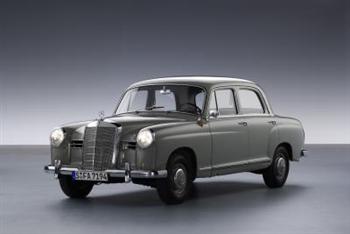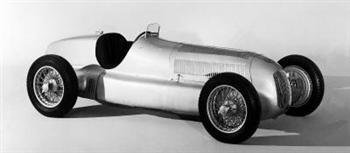|
Home | News | Road Tests | ||||||||||||||||||
Mercedes-Benz at Techno Classica 2009
Home > News > Mercedes-Benz 5th April, 2009
The E-Class took centre stage for Mercedes-Benz at this week-end's Techno Classica, the world's biggest classic car show, held in Essen, Germany. Nine generations from six decades plus one E-Class forerunner was present, from the 260 D that debuted in 1936 to the brand-new E-Class of model series W 212. "With this array of exhibits Mercedes-Benz documents the great importance of the E-Class," says Michael Bock, Managing Director Mercedes-Benz Museum GmbH. "The E-Class is a companion of economic success, especially in Germany." Beyond that, the E-Class also has left a deep impression on automotive history in general with technical innovations and stylish design. In addition, a special show which featured the Mercedes-Benz Silver Arrows gave the Techno Classica a motor sports flair – 75 years ago, in 1934, the legendary W 25 Grand Prix racing car entered its first competition. It was on hand in Essen along with several of the later Silver Arrows, including the world championship cars of Mika Häkkinen from 1998 and Lewis Hamilton from 2008. The Benz Patent Motor Car of 1886 completed the show appearance. A faithful replica of the world's first automobile was on display. Mercedes-Benz Young Classics presented itself in the foyer of the south entrance of the exhibition site. In this new initiative, Mercedes-Benz offers the brand's young classics for sale or rental. In addition, Young Classics arranges financing or insurance for vintage cars. The Mercedes-Benz stand covered around 4,500 square metres this year, including all partners and the brand clubs. The world's most successful luxury saloon Hardly another model series stands as much for economic success and growth in the time after the Second World War as the E-Class. The direct and unbroken line of 'ancestors' was established in 1947 by the 170 V (W 136 series), and it comprises a total of nine generations up to and including the W 212 series launched in 2009. But ever since the beginning of the 20th century, intermediate and luxury class cars have been a central element of the model ranges of the Mercedes and Benz brands. Nine generations of the E-Class stand for technical innovation and pace-setting design too. No other car class of the Stuttgart brand has offered such a variety of body types in the past 60 years, from saloon, estate, coupé and cabriolet to special types such as chassis and long-wheelbase saloons. Since 1947 Mercedes-Benz has manufactured a total of over ten million saloons of the model family to make the E-Class far and away the world's most successful luxury saloon. At Techno Classica Mercedes-Benz presented ten original cars from the E-Class and its predecessors. Mercedes-Benz 260 D, 1936 to 1940: The Mercedes-Benz 260 D presented in the spring of 1936 at the International Automobile and Motor Cycle Show in Berlin was the world's first production car with a diesel engine. Owing to its low consumption and the low price of diesel fuel it was particularly economical. Along with its frugal consumption, the 260 D also impressed with pronounced reliability and longevity. In the Pullman saloon version it was the ideal taxi, and it was a popular touring saloon as well. But with 1,967 units built, at first it played only a subordinate role alongside the 230 model, its petrol-powered counterpart of which around 20,000 units were built. As an upscale middle-of-the-range model the 260 D forms part of the roots of the E-Class. A 260 D Pullman saloon dating from 1939 was also on display. Series W 136 and W 191, 1947 to 1955: In 1947 the 170 V, the first post-war passenger car from Mercedes-Benz, went into production and simultaneously established the direct ancestral line of the E-Class. It was largely based on the pre-war model of the same name, and during the next years formed the backbone of the car range of Mercedes-Benz. From the saloon with 1.7-litre petrol engine, in 1949 the engineers derived not only the 170 D diesel car, but also supplemented the range with the prestigious 170 S saloon, available also as diesel variant 170 DS as of 1952. With spacious body, high ride comfort and solid high-class appeal, these models embodied attributes which are strong points of the E-Class even today. A 170 V model manufactured in 1950 was on display. Series W 120 and W 121, 1953 to 1962: A new era dawned with the Mercedes-Benz 180 in August 1953. Its self-supporting chassis/body structure marks the departure from the traditional design with chassis and separate body. The integral three-box "Ponton" was regarded as very progressive and reduced wind resistance and fuel consumption. So the 180 model is a symbol of the innovative power of Mercedes-Benz that finds expression over and over again in the development of the E-Class. In 1954 the diesel variant 180 D followed; as third model the Mercedes-Benz 190 was included in the range in 1956, and the 190 D debuted in 1958. All in all around 443,000 four-cylinder "Ponton" models were built. A 180 model manufactured in 1958 was on display. Series W 110, 1961 to 1968: The next generation of the intermediate range of Mercedes-Benz can be recognised by the distinctive upright, pointed elements on the rear guards that gave the series the nickname "Fintail". It is not just the successful combination of spaciousness, comfort, performance, good value for money, and economy that set standards. In the area of safety it was the rigid passenger cell surrounded by crumple zones at the front and rear. The first models available were the 190 and 190 D saloons. From 1962 on they became available for the first time with automatic transmissions. In 1965 models with improved appointments and engineering followed, the 200 and 200 D. In the 230 that premiered simultaneously, a six-cylinder model complemented the product range. The advances in handling safety were documented in 1963 by the dual-circuit brake system with brake booster and front disc brakes. A 200 model built in 1965 is on display. Series W 114 and W 115, 1968 to 1976: By the time production of this saloon introduced in early 1968 ceased, with more than 1.8 million units it had become the first Mercedes-Benz car model series to 'crack' the million mark. The first models available were the four-cylinder 200, 220, 200 D and 220 D along with the six-cylinder models 230 and 250. For the first time an elegant coupé version also was available. The successful two-door gave a little foretaste of the future variety of models in the intermediate range of Mercedes-Benz. In 1972 the 280 and 280 E joined the series as new top-of-the-range models. In the 240 D 3.0 of 1974 the first five-cylinder diesel engine in a production car marked a world premiere. Among experts the W 114/115 series is known mainly by its nickname: it was called "Stroke 8" because in the internal company documentation the model designations carry the suffix "/8", to show the year in which the series was launched, 1968. A 220 D built in 1969 was on display. Series W 123, 1976 to 1985: In January 1976 the new generation excited customers with its great variety. In the series' first year, the models 200, 230, 250, 280 and 280 E as well as 200 D, 220 D, 240 D and 300 D were put on sale. The coupé, the long-wheelbase saloon and the estate – the first Mercedes-Benz estate ex factory – followed the saloon in 1977. Comfort and safety were exemplary owing to the rigid passenger cell, the innovative safety steering column, and the crash-protected fuel tank. From 1980 the anti-lock braking system ABS was available; two years later, the airbag. The series is the most successful in the annals of the E-Class: around 2.7 million units were built, including almost 2.4 million saloons and some 200,000 estates. On display was a 230 E built in 1982. Series W 124, 1984 to 1996: The 124 series introduced in 1984 is the first vehicle 'family' from Mercedes-Benz that bore the name E-Class, beginning in 1993. Uncompromising light weight design and optimised aerodynamics ensured lower fuel consumption. A closed-loop catalytic converter that effectively cut pollutant emissions was available for all petrol models from 1985, five years later for the diesel models as well. The innovative multi-link independent rear suspension made highest levels of comfort and safety possible. The model range was made even more varied with the body variants saloon, estate, coupé, cabriolet and long-wheelbase saloon. In addition, in the saloon and estate models of the intermediate range Mercedes-Benz introduced 4MATIC four-wheel drive and the first four-valve-per-cylinder diesel engines. On display was an E 500 built in 1994. Series W 210, 1995 to 2002: The new intermediate series from Mercedes-Benz viewed the world through four "eyes" in 1995 and immediately won the "red dot design award". For the first time the E-Class afforded a choice between three design and equipment lines: CLASSIC, ELEGANCE and AVANTGARDE. Numerous technical highlights from the Electronic Traction System 4ETS to the belt force limiter were part of the standard equipment. The new E-Class entered the market in 1995 with models E 200, E 230, E 280, E 320 and E 420 as well as E 220 Diesel, E 290 Turbodiesel and E 300 Diesel. In subsequent years further models were added to the series, including the innovative E 220 CDI (1998) with common-rail direct injection and the E 200 Kompressor (2000). As of the northern autumn of 1999 all models of the E-Class were equipped with the Electronic Stability Programme ESP®. On display was an E 200 model built in 2000. Series W 211, 2002 to 2009: A new generation of the E-Class was introduced in 2002. Its technical innovations ranged from adaptive front airbags through two-stage belt force limiters to the active light function with bi-xenon headlamps and a sensor-controlled automatic climate control. In 2004 Mercedes-Benz presented the E 200 NGT, the most powerful production saloon with an eco-friendly natural gas drive. In 2005 three production E 320 CDI models set a long-distance speed record on a circuit in Laredo, Texas, USA, covering 100,000 miles (around 160,000 kilometres) at an average speed of 224.823 km/h – one of the record-setting cars was on display at Techno Classica. In 2006 the E 320 BlueTEC was the first car in which Mercedes-Benz marketed the world's cleanest diesel technology. In 2007 the E 350 CGI with an ultra-modern petrol direct-injection engine made its appearance. The renowned US market research institute J. D. Power and Associates presented the "J. D. Power Award" in gold to the E-Class in 2008 for being the highest-quality car in its market segment. Series W 212, as of 2009: The new Mercedes-Benz E-Class is the trend setter for safety, comfort and environmental compatibility in this market segment. The saloon further extends the brand's leading position in the luxury class with an unrivalled combination of driving assistance systems. They include, for example, ATTENTION ASSIST for drowsiness detection, the Adaptive Highbeam Assist, and automatic emergency braking, activated when the acute risk of an accident arises. The long-distance cruising comfort so characteristic of the E-Class is enhanced by Mercedes-Benz in the new saloon, for example, through intelligent body engineering with an increase in rigidity of up to 30 per cent, with further improved seats and a newly developed suspension whose shock absorbers automatically adapt to the situation at hand. Just as outstanding as the safety and comfort are the environmental compatibility and economy: the four- and six-cylinder engines are direct injection units which use as much as 23 per cent less fuel than before. The new CDI four-cylinders make do with just 5.3 litres per 100 kilometres (combined) in the European driving cycle. This translates to 139 grammes of carbon dioxide per kilometre. On display was an E 250 CDI BlueEFFICIENCY model from the newly introduced range.
75 years of the Mercedes-Benz Silver Arrows In 2009 Mercedes-Benz celebrates an outstanding anniversary: 75 years of the Silver Arrows. The first racing car bearing this legendary name made its appearance in 1934. This car and its successors scored top results in international races, set standards in terms of performance, and put the engineering to the 'acid' test. The Mercedes-Benz Silver Arrows are evidence for the company's commitment to competition – every year and with every driver. At the same time, every victory clinched with these classic racing cars and every record established contributes to a legend which has been intriguing people to this very day, and which is effortlessly being continued by the modern-day Silver Arrows which have been entered in racing since the 1990s. At Techno Classica Mercedes-Benz presents six Silver Arrows, the oldest dating from 1934, the youngest from 2008. Mercedes-Benz W 25, 1934 to 1936: The Mercedes-Benz W 25 with supercharged eight-cylinder engine was built for the 750 kg formula racing class introduced in 1934. Without fuel, oil and tyres the Grand Prix cars were allowed to weigh no more than 750 kilogrammes. Manfred von Brauchitsch drove the new car to victory on its first start, in the Eifel race on the Nürburgring. During the time it was used, from 1934 to 1936, the W 25 repeatedly was modified and equipped with increasingly more powerful engines. Mercedes-Benz managed 15 victories with it, including five double victories and one triple win, and Rudolf Caracciola was European champion in 1935. Mercedes-Benz W 125, 1937: The Mercedes-Benz W 125 also was built for the 750 kilogramme formula that determined the rules for Grand Prix racing cars until 1937. It was completely redesigned in the aftermath of the less successful 1936 season. Very successfully: the W 125 not only won the first race it entered, the Grand Prix of Tripoli, but chalked up six first-place, nine second-place and six third-place finishes in 12 international races in 1937. Down to the beginning of the 1980s it had the reputation for being the most powerful car to ever start in a Grand Prix race. Rudolf Caracciola won his second European championship in the W 125 in 1937. Mercedes-Benz W 154, 1938 to 1939: For the 1938 season, the weight of the racing cars was no longer limited, but the displacement: to a maximum three litres with and 4.5 litres without supercharger. Mercedes-Benz had the right answer in the supercharged W 154, the make's first twelve-cylinder car. It won six of the nine most important races in 1938 – including three triple victories and one double – and helped Caracciola gain his third European champion's title; in 1939 the revised and uprated W 154 won five out of seven races. The most successful driver was Hermann Lang, who accounted for four of the five wins. Mercedes-Benz W 196 R, 1954 to 1955:
The first race in which the new 2.5-litre W 196 R competed, the French Grand Prix, ended in a double victory for Juan Manuel Fangio and Karl Kling – what a brilliant return of the Silver Arrows to the Formula 1. For the high-speed course in Reims the flashy streamlined version of the racing car was the right choice. However, in most races of 1954 and 1955 the conventional racing car with exposed wheels was used – it was better for race tracks full of bends. The W 196 R scored three more victories in 1954, even five the following year, and Fangio became world champion in both years. McLaren-Mercedes MP4-13, 1998: In the 1997 season, a silver-coloured car developed jointly with McLaren entered competition for the first time. In its first race the McLaren-Mercedes MP4-12 driven by David Coulthard won the Australian Grand Prix in Melbourne to get the season off to a good start. Wins in Monza and Jerez followed. The MP4-13 was developed to comply with the new regulations for 1998. It demonstrated its dominance in its very first race: the two cars with Häkkinen and Coulthard at the wheel both finished a lap ahead of the third-place car. The MP4-13 helped Mika Häkkinen win the Formula 1 World Championship driver's title, while the team won the Formula 1 World Champion Constructor's title. McLaren-Mercedes MP4-23, 2008: Following the successful 2007 racing season, in which the McLaren-Mercedes team competed with the MP4-22, the successor model was developed for 2008. The MP4-23 also won its maiden race, the Australian Grand Prix in March 2008. McLaren Mercedes won five more races in this season (and placed second three times and third four times) to finish second in the constructors' competition. Lewis Hamilton wrote racing history in this car, capturing the World Championship driver's title on the last bend of the season's last race after finishing the previous season as runner-up. | ||||||||||||||||||
More Mercedes-Benz News .....
here
About | Car Clubs | Home | News | Road Ramblings | Road Tests | Subscribe | Top Drive © 2009 All rights reserved. Next Car Pty. Ltd. |





